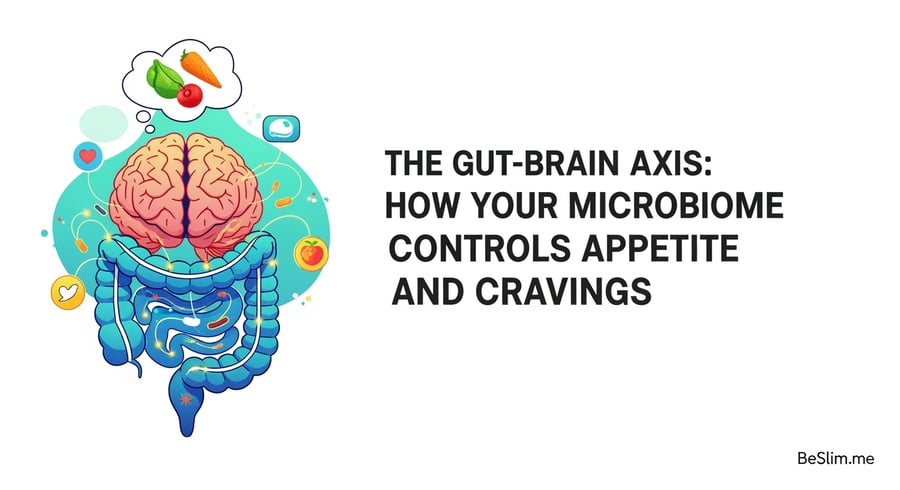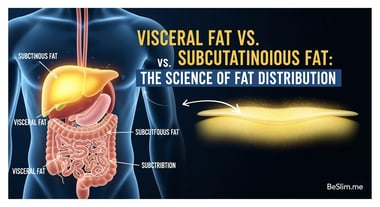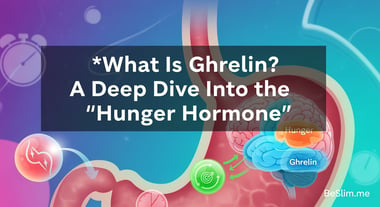Hello, I'm Master Kim, the founder and Chief Scientific Officer of BeSlim.me. With years of experience guiding individuals on their weight loss journeys, I've seen firsthand how the intricate connection between our gut and brain can make or break our efforts to manage appetite and cravings. It's not just about willpower; it's about understanding the biological signals that influence our eating behaviors. If you've ever felt overwhelmed by sudden hunger pangs or irresistible cravings, you're not alone—I've been there too. In this article, we'll explore the gut-brain axis and its profound impact on weight management. Let's empower you with knowledge to take control.
Understanding the Gut-Brain Axis: The Foundation of Mind-Gut Communication
The gut-brain axis represents a bidirectional communication network linking the gastrointestinal tract with the central nervous system. This axis plays a pivotal role in regulating various physiological processes, including digestion, mood, and notably, appetite control. At its core, the axis involves the enteric nervous system—often called the "second brain"—which operates semi-independently in the gut while exchanging signals with the brain via neural, hormonal, and immune pathways.
To grasp this concept, consider how the vagus nerve serves as a primary conduit for these signals. Sensory neurons in the gut detect changes in nutrient levels, microbial activity, and inflammation, relaying information to the brainstem and higher brain regions like the hypothalamus, which governs hunger and satiety. This communication isn't one-way; the brain can influence gut motility and secretion in response to stress or emotions, creating a feedback loop.
When it comes to weight management, disruptions in this axis can lead to dysregulated appetite, overeating, and obesity. For instance, chronic stress might alter gut permeability, allowing inflammatory signals to reach the brain and exacerbate cravings for high-calorie foods. This foundational understanding sets the stage for deeper exploration.
Let's dive into the science behind this. The gut-brain axis modulates appetite through specific mechanisms, such as the release of gut hormones like ghrelin and leptin, which signal hunger and fullness to the brain. Research indicates that an imbalanced gut microbiome can impair these signals, contributing to weight gain.
(Suggestion: A simple diagram here illustrating the bidirectional pathways of the gut-brain axis—showing the vagus nerve, hormone release, and brain regions—would enhance visual understanding of this communication network.)
The Role of the Gut Microbiome in Appetite Regulation
The gut microbiome, comprising trillions of bacteria, viruses, fungi, and other microbes, is a key player in the gut-brain axis. These microorganisms influence appetite by producing metabolites that interact with host cells and signaling pathways. For example, short-chain fatty acids (SCFAs) like acetate, propionate, and butyrate—produced through microbial fermentation of dietary fiber—can cross the blood-brain barrier or stimulate enteroendocrine cells in the gut to release appetite-regulating hormones.
In detail, SCFAs bind to G-protein-coupled receptors (such as GPR41 and GPR43) on intestinal cells, triggering the secretion of peptide YY (PYY) and glucagon-like peptide-1 (GLP-1). These hormones travel via the bloodstream to the brain, where they activate satiety centers in the hypothalamus, reducing food intake. Conversely, an unhealthy microbiome dominated by pro-inflammatory bacteria can produce lipopolysaccharides (LPS), which induce low-grade inflammation and disrupt these signals, leading to increased appetite and cravings for energy-dense foods.
This microbial influence extends to neurotransmitter production. Gut bacteria synthesize compounds like serotonin precursors, with about 90% of the body's serotonin originating in the gut. Imbalances here can affect mood and emotional eating, often linked to weight fluctuations.
The mechanism is further illuminated by studies showing that microbial diversity correlates with body mass index (BMI). A diverse microbiome promotes efficient energy harvest from food without excessive storage as fat, while dysbiosis (microbial imbalance) can lead to increased caloric extraction and fat accumulation.
According to recent research, gut microbiota alterations are associated with obesity through mechanisms involving energy homeostasis and inflammation.
Biological Mechanisms Linking the Gut-Brain Axis to Weight Management
Delving deeper into the biological underpinnings, the gut-brain axis affects weight through intricate cell signaling and hormone actions. At the cellular level, enteroendocrine cells in the intestinal lining act as sensors, detecting nutrients and microbial byproducts. Upon stimulation, these cells release hormones that modulate vagal afferents, which carry signals to the nucleus tractus solitarius in the brainstem. From there, projections extend to the arcuate nucleus of the hypothalamus, where neurons expressing pro-opiomelanocortin (POMC) promote satiety, while those with neuropeptide Y (NPY) and agouti-related peptide (AgRP) stimulate hunger.
A key mechanism involves leptin, produced by adipose tissue, which crosses the blood-brain barrier to inhibit NPY/AgRP neurons and activate POMC neurons, signaling fullness. However, gut dysbiosis can induce leptin resistance by promoting inflammation via cytokine release (e.g., TNF-α and IL-6), impairing this feedback and leading to overeating. Similarly, ghrelin, secreted by the stomach, stimulates appetite by activating NPY/AgRP pathways; microbial metabolites can modulate ghrelin levels, with certain bacteria reducing its secretion to curb hunger.
Immune-mediated pathways also play a role. Toll-like receptors (TLRs) on gut epithelial cells recognize microbial patterns, triggering immune responses that influence brain function. Chronic activation of TLRs in dysbiosis states can lead to neuroinflammation, altering reward pathways in the brain and heightening cravings for palatable foods, which contributes to weight gain.
Furthermore, the axis impacts energy metabolism. Microbial production of bile acid metabolites influences farnesoid X receptor (FXR) signaling, which regulates glucose and lipid metabolism. Disruptions here can lead to insulin resistance, a precursor to obesity.
Research supports that the gut-brain axis regulates energy balance via microbial modulation of host metabolism and appetite hormones.
(Suggestion: A comparison table here contrasting a healthy vs. dysbiotic microbiome—listing effects on hormones, inflammation, and weight outcomes—would provide a scannable overview of these mechanisms.)
Practical Strategies to Optimize Your Gut-Brain Axis for Weight Control
Building on these insights, optimizing the gut-brain axis can be a game-changer for managing weight. By fostering a healthy microbiome, you can better regulate appetite and reduce cravings, leading to sustainable weight loss.
Actionable takeaways include incorporating fiber-rich foods like vegetables, fruits, and whole grains to boost SCFA production and support satiety hormones. Aim for 25-30 grams of fiber daily—I recommend starting with small additions, like adding chia seeds to your morning yogurt, to avoid digestive discomfort.
Probiotic and prebiotic supplements can help restore microbial balance. Foods like yogurt, kefir, and fermented vegetables introduce beneficial bacteria, while prebiotics in garlic, onions, and bananas nourish them. In my experience at BeSlim.me, clients who combined these with mindful eating saw reduced cravings within weeks.
Manage stress through practices like meditation or yoga, as chronic stress disrupts the axis. Regular exercise also enhances microbial diversity and vagal tone, improving gut-brain signaling.
Monitor your progress by tracking hunger patterns and adjusting your diet accordingly. If cravings persist, consult a healthcare professional to rule out underlying issues.
Studies confirm that dietary interventions targeting the microbiome aid weight loss by improving appetite control and metabolic health.
Remember, these changes aren't overnight fixes, but with consistency, you'll notice a shift in how your body signals hunger. At BeSlim.me, we've helped countless individuals harness this knowledge for lasting results—I'm confident you can too.
References
Medical Disclaimer
The content on this website is for informational and educational purposes only. It is not intended as medical advice and should not be relied upon as a substitute for consultations with qualified healthcare professionals who are familiar with your individual medical needs. Always seek the advice of your physician or other qualified healthcare provider with any questions you may have regarding a medical condition. Never disregard professional medical advice or delay in seeking it because of something you have read on this website.





Comments (0)
No comments yet. Be the first to comment!